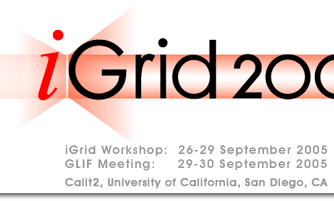News Releases
Next Level in High-Definition Videoconferencing Demonstrated at iGrid Conference at UCSD
By Doug Ramsey
San Diego, CA, October 3, 2005 - For a few days last week, UCSD was at the center of a technological revolution that may reshape the entertainment industry and give scientists a new way to collaborate and share data - even from thousands of miles away.
Case in point: one of the world’s leading scholars on the Gutenberg Bible gave a lecture on the digital preservation of the four dozen or so extant ‘first editions’ of the Bible. Through the miracle of modern telecommunications, the Keio University scholar in a Tokyo studio was speaking and interacting with a packed crowd at UCSD, even pointing out the close-up detail of a single, ornate letter from the Gutenberg now in Keio’s collection. The lecture, in super-high-definition video, traveled 9,000 miles through optical-fiber networks, at such speeds that there was virtually no delay between questions and answers between Tokyo and San Diego.
It was the first international real-time, two-way transmission of video in 4K - a digital cinema format that has four times the resolution of today’s most widely used commercial version of high-definition television.
The 4K event was the first of many records set by grid, visualization and networking researchers during iGrid 2005, which was hosted by the California Institute for Telecommunications and Information Technology (Calit2) in its new building at UCSD.
The iGrid get-together happens every two or three years, when advances in grid computing and global network technology jump to the next level. This year, that meant doubling the bandwidth going in and out of UCSD to more than 100 Gigabits per second (Gbps), and turning the Calit2 building into a world-class hub for international networking experiments.
The broadband pipes connecting research institutions are now so ‘fat’ that data can stream literally faster than the speed of light. If you have a 56K dial-up modem at home, you are accessing the Internet at less than 56,000 bits per second. Three years ago, scientists were thrilled to get access to bandwidth of 1 billion bits per second (i.e., 1 Gigabit per second). But at iGrid this year, there were multiple 10 Gbps fiber connections reaching from San Diego to Chicago, Amsterdam, Tokyo and beyond.
10 Gbps is now the state of the art, but not for long. One set of Dutch researchers harnessed two 10 Gbps lines and streamed 3D visualizations across the Atlantic that achieved an average sustained speed of 18 Gbps. Said Dutch researcher Paul Wielinga: This is a world record for bandwidth usage by one single application showing actual scientific content.
The vivid images included a 3D teapot visualization that was shown on a 105-million-pixel display, the largest ever constructed for scientific use.
Among other ‘firsts’ at iGrid, the University of Washington and ResearchChannel presented the first-ever IP-based live program in high-definition video from the bottom of the sea. And another team demonstrated the first international collaboration in real time on ‘digital dailies’ for 4K video (which has roughly the resolution of film); the technology will allow a director in one city to work simultaneously with 4K video shot halfway around the world almost as easily as if the video was located in an editing room down the hall.
A group of Hollywood studios has already set its sights on 4K as a future standard for digital cinema distribution, and the Calit2 auditorium was transformed into a digital cinema - with fresh popcorn available at the entrance! Inside, a prototype 4K projector lent by Sony displayed the super-high-definition video and images onto a 30x20-foot screen, providing an experience that represents the closest thing to ‘being there.’ The best way to describe this is 4K telepresence via a Gigabit IP network, said Laurin Herr, Calit2 participant and president of Pacific Interface, who midwifed the 4K demonstrations. It’s that real.
Roughly a dozen examples of scientific, informational and artistic programming streamed in real time from Tokyo, Chicago and elsewhere. An original short 4K movie premiered, but it was the live interaction with people in a Tokyo conference room that especially wowed the audience at UCSD.
To accompany the amazing visuals, UCSD music professor Peter Otto oversaw another first achieving a sustained streaming of 24 tracks of uncompressed professional quality audio over gigabit IP networks from Skywalker Sound servers in Oakland to the Calit2 building. The audio was precisely synchronized with the 4K digital motion pictures streaming to San Diego. Otto and a team from UCSD’s Center for Research in Computing and the Arts also produced original music for new animations and videos showcasing the power of 4K.
Related Links:
http://ucsdnews.ucsd.edu/thisweek/2005/oct/10_03_video.asp


